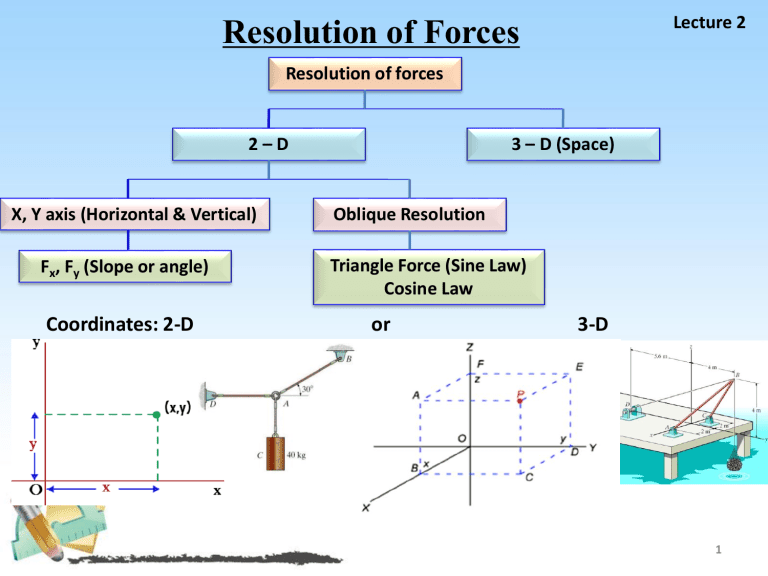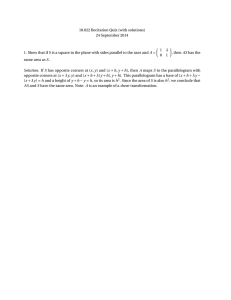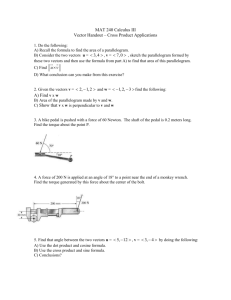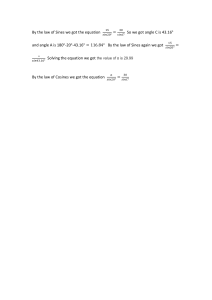
Lecture 2 Resolution of Forces Resolution of forces 2–D X, Y axis (Horizontal & Vertical) Fx, Fy (Slope or angle) Coordinates: 2-D 3 – D (Space) Oblique Resolution Triangle Force (Sine Law) Cosine Law or 3-D 1 Resolution of Forces Lecture 2 The process of replacing a force system by its components is called Resolution. To resolve a force into x-y components means to express the force as the sum of two forces, one in the x-direction (the x-component) and one in the y-direction (the ycomponent), When resolving a force into x-y components, we must have information on the direction of the force and the magnitude of the force. 2 Resolution of Forces Lecture 2 When the angle of the force relative to the x- or y-axes is known, we can use trigonometry to find the components. Let ( θ ) be the angle that the force makes with the positive x-axis. Using trigonometry, we find the components ( Fx and Fy ) as follows: It is usually easiest to find the magnitudes of the components from the acute angle of the triangle defined by the force and the axes. Note that the components may have positive or negative signs. You need to recognize the signs of the components so they agree with their senses. 3 Resolution of Forces Lecture 2 Oblique Components (Oblique Forces): If non-rectangular components of a force are needed, several methods are available for determining them. The components of the force ( F ) shown as (OA) and (OB) can be determined graphically by drawing the parallelogram to any convenient scale. The magnitudes of the components can be determined algebraically from the law of sines & cosines [With reference to triangle (ABC) with sides of ( a, b, c ), the sine rule states] which states: Parallelogram Laws: y B C F O x A Sine Law: Cosine Law: 4 Composition of Forces Lecture 2 The process of replacing a force system by its resultant is called composition. The Resultant of a pair of concurrent (occurring at the same time and gathering at the same point) forces can be determined by means of Parallelogram Law, which states that: Two forces on a body can be replaced by a single force called the resultant by drawing the diagonal of the parallelogram with sides equivalent to the two forces. For example if F1 and F2 are two forces, the resultant ( R ) can be found by constructing the parallelogram. 5 Resolution of Forces in 3 – D space Lecture 2 It is convenient to resolve a force in space into three mutually perpendicular components parallel to three coordinates axes. The resultant ( R ) could be first resolved into two components along (AC) and (CD) by means the parallelogram law, and the component along (CD) could then be resolved into components along (AE) and (AF). From the figure it is apparent that: The angles (qx , qy and qz ) are the angles between the resultant force and the positive coordinate axes. The cosines of these angles are called direction cosines. The summation of cosine’s squares of these angles is equal ( 1 ): If the angle is higher than (90o), the cosine is negative, indicating that the component is opposite the positive direction. 6 Resolution and Composition of Forces Lecture 2 Oblique Forces : Parallelogram Law Example: Resolve the force(113.5 N) into two components along AB and AD. 7 Example 1 Lecture 2 Y Resolve the (1000 N) force acting on the pipe, into components in the (a) X and Y directions, and (b) X’ and Y directions. 1000 N 40o Solution: 30o X Part (a): note that the length of the components is scaled along the X and Y axes by first constructing lines from the tip of ( F = 1000 N ) parallel to the axes in accordance with the parallelogram law. X’ 1000 N Y Part (b): note carefully how the parallelogram is constructed. Applying the law of sines using data mentioned in figure, it will yield: 1000 N Fy 40o Fx Fy 40o X Fx Y Fy 1000 N 50o 1000 N Fy 50o 70o 70o 60o Fx’ 60o X’ Fx’ 8 Example 2 Lecture 2 The screw eye is subjected to two forces, F1 and F2. determine the magnitude and direction of the resultant force. Solution: Parallelogram Law: The parallelogram law of addition is shown in figure below. The two unknowns are the magnitude of ( FR ) and the angle ( q ). Trigonometry: from the figure, the vector triangle is constructed. FR is determined by using the law of cosines: The angle ( q ) is determined by applying the law of sines, using the computed value of ( FR ): Thus, the direction ( f ) of ( FR ), measured from the horizontal is: 9


